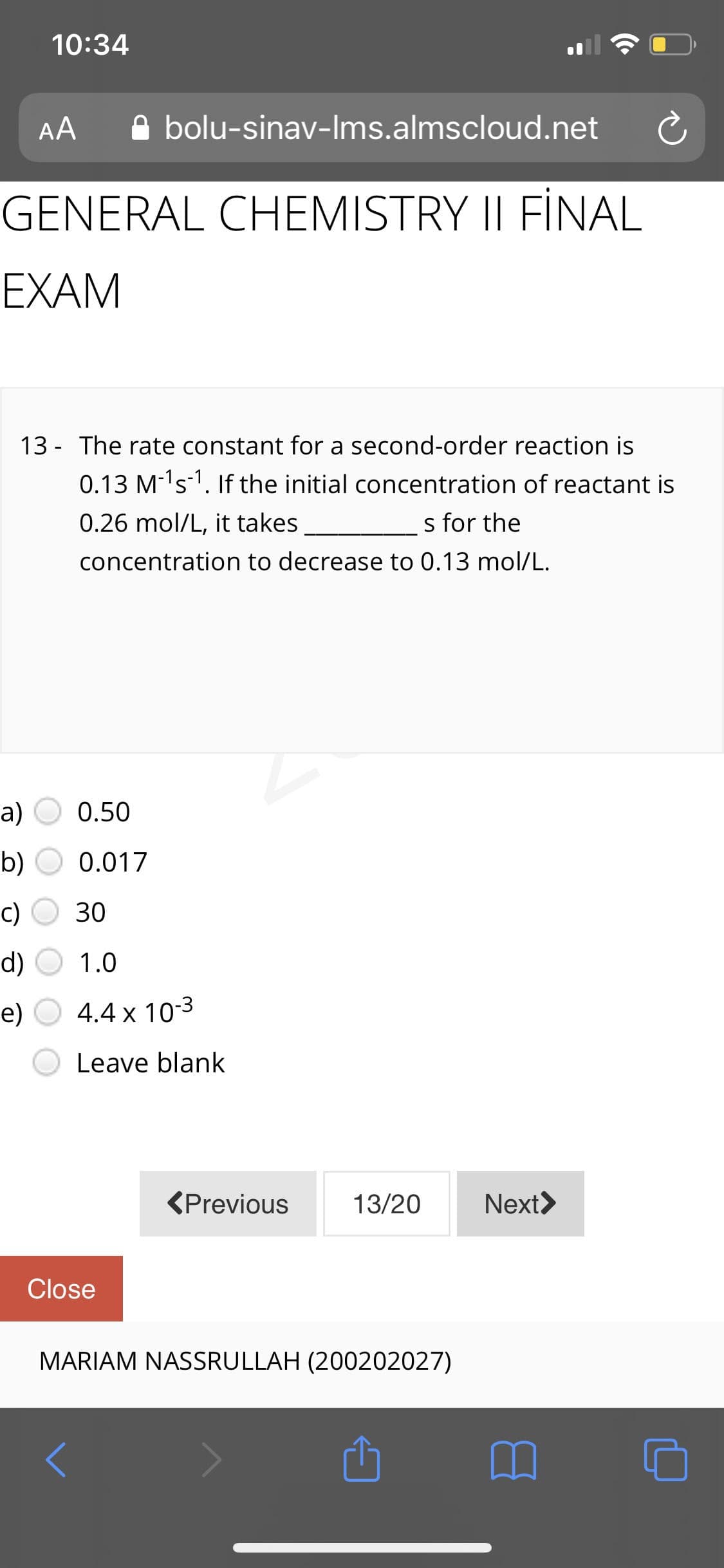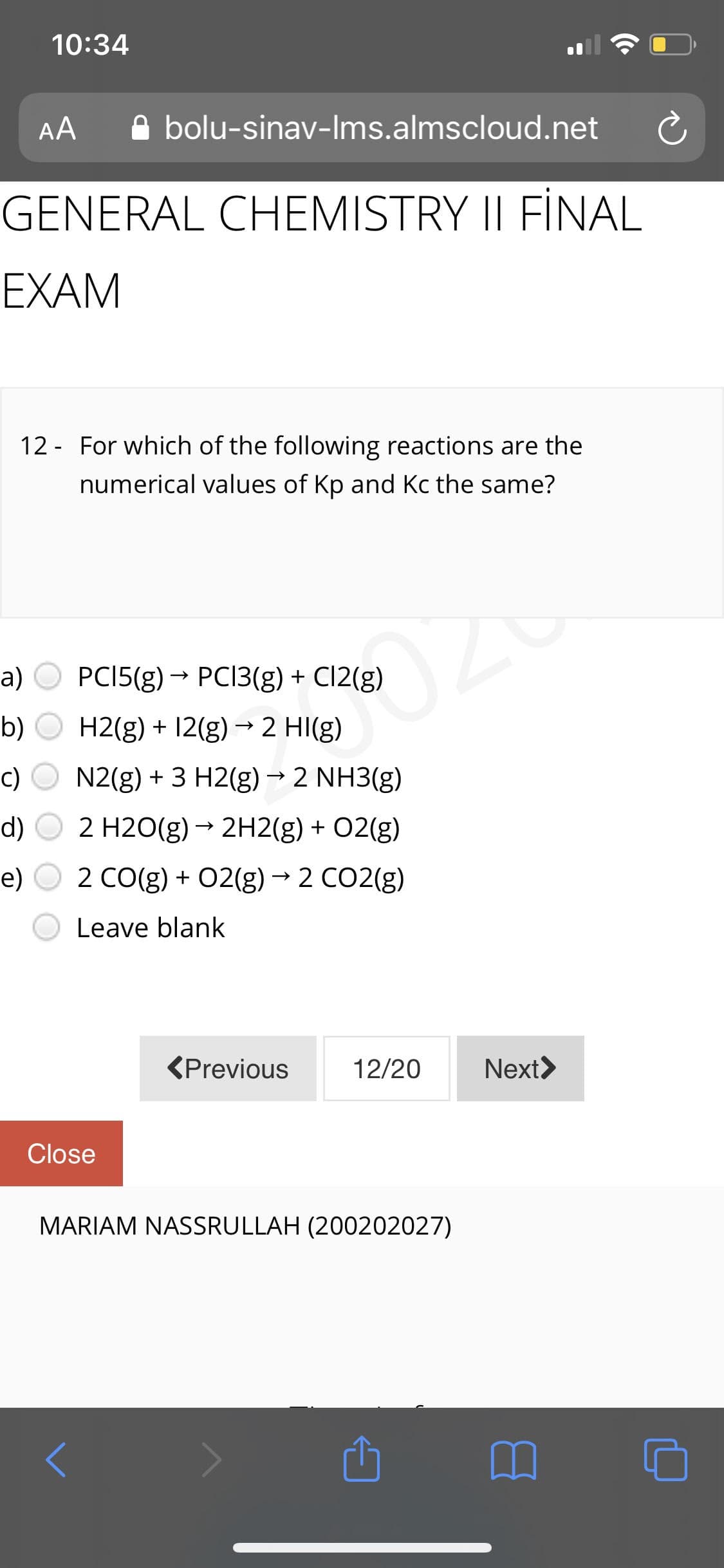13 - The rate constant for a second-order reaction is 0.13 M-'s-1. If the initial concentration of reactant is 0.26 mol/L, it takes s for the concentration to decrease to 0.13 mol/L. a) 0.50 (с 0.017 =) O 30 d) O 1.0 4.4 x 10-3 Leave blank
13 - The rate constant for a second-order reaction is 0.13 M-'s-1. If the initial concentration of reactant is 0.26 mol/L, it takes s for the concentration to decrease to 0.13 mol/L. a) 0.50 (с 0.017 =) O 30 d) O 1.0 4.4 x 10-3 Leave blank
Chemistry by OpenStax (2015-05-04)
1st Edition
ISBN:9781938168390
Author:Klaus Theopold, Richard H Langley, Paul Flowers, William R. Robinson, Mark Blaser
Publisher:Klaus Theopold, Richard H Langley, Paul Flowers, William R. Robinson, Mark Blaser
Chapter12: Kinetics
Section: Chapter Questions
Problem 32E: Describe how graphical methods can be used to determine the order of a reaction and its rate...
Related questions
Question

Transcribed Image Text:10:34
AA
A bolu-sinav-Ims.almscloud.net
GENERAL CHEMISTRY II FİNAL
EXAM
13 - The rate constant for a second-order reaction is
0.13 M-'s-1. If the initial concentration of reactant is
0.26 mol/L, it takes
s for the
concentration to decrease to 0.13 mol/L.
a) O 0.50
b)
0.017
c)
30
d)
1.0
е)
4.4 x 10-3
Leave blank
<Previous
13/20
Next>
Close
MARIAM NASSRULLAH (200202027)

Transcribed Image Text:10:34
AA
A bolu-sinav-Ims.almscloud.net
GENERAL CHEMISTRY II FİNAL
EXAM
12 - For which of the following reactions are the
numerical values of Kp and Kc the same?
a)
PCI5(g) → PCI3(g) + C12(g)
->
b)
H2(g) + 12(g) → 2 HI(g)
c)
N2(g) + 3 H2(g) → 2 NH3(g)
d)
2 H2O(g) → 2H2(g) + 02(g)
e)
2 CO(g) + 02(g)→ 2 CO2(g)
Leave blank
<Previous
12/20
Next>
Close
MARIAM NASSRULLAH (200202027)
Expert Solution
This question has been solved!
Explore an expertly crafted, step-by-step solution for a thorough understanding of key concepts.
This is a popular solution!
Trending now
This is a popular solution!
Step by step
Solved in 2 steps with 6 images

Knowledge Booster
Learn more about
Need a deep-dive on the concept behind this application? Look no further. Learn more about this topic, chemistry and related others by exploring similar questions and additional content below.Recommended textbooks for you

Chemistry by OpenStax (2015-05-04)
Chemistry
ISBN:
9781938168390
Author:
Klaus Theopold, Richard H Langley, Paul Flowers, William R. Robinson, Mark Blaser
Publisher:
OpenStax

Chemistry: The Molecular Science
Chemistry
ISBN:
9781285199047
Author:
John W. Moore, Conrad L. Stanitski
Publisher:
Cengage Learning

Chemistry for Engineering Students
Chemistry
ISBN:
9781337398909
Author:
Lawrence S. Brown, Tom Holme
Publisher:
Cengage Learning

Chemistry by OpenStax (2015-05-04)
Chemistry
ISBN:
9781938168390
Author:
Klaus Theopold, Richard H Langley, Paul Flowers, William R. Robinson, Mark Blaser
Publisher:
OpenStax

Chemistry: The Molecular Science
Chemistry
ISBN:
9781285199047
Author:
John W. Moore, Conrad L. Stanitski
Publisher:
Cengage Learning

Chemistry for Engineering Students
Chemistry
ISBN:
9781337398909
Author:
Lawrence S. Brown, Tom Holme
Publisher:
Cengage Learning

Chemistry & Chemical Reactivity
Chemistry
ISBN:
9781337399074
Author:
John C. Kotz, Paul M. Treichel, John Townsend, David Treichel
Publisher:
Cengage Learning

Chemistry
Chemistry
ISBN:
9781305957404
Author:
Steven S. Zumdahl, Susan A. Zumdahl, Donald J. DeCoste
Publisher:
Cengage Learning

Chemistry: An Atoms First Approach
Chemistry
ISBN:
9781305079243
Author:
Steven S. Zumdahl, Susan A. Zumdahl
Publisher:
Cengage Learning